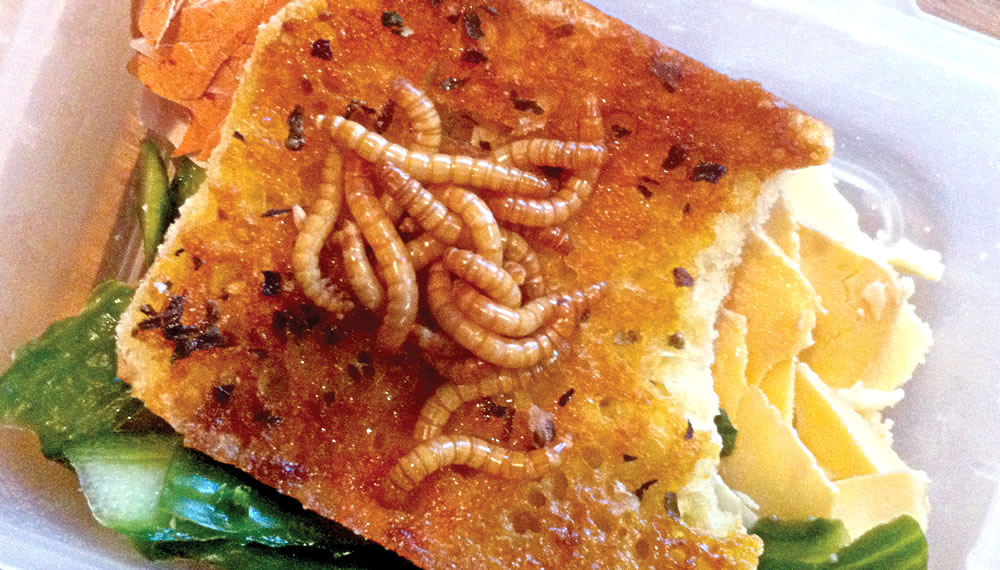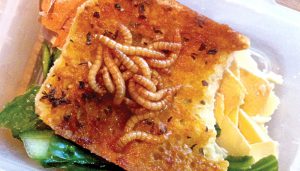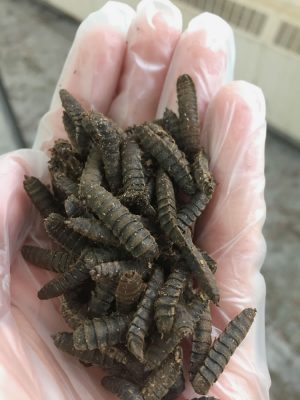The practice of entotechnology is another sustainable method to organic waste processing — producing food, whether for people, animals or fish.
Marsha W. Johnston
BioCycle June 2017
As one solution, the United Nations’ Food and Agriculture Organization (FAO) has proposed people eat insects because farming insects has a much smaller environmental impact per kilogram of protein than does animal farming. Animal farming is responsible for 18 percent of carbon dioxide (CO2) emissions and uses 70 percent of worldwide water. Industry research firms such as Global Market Insights forecast that the edible insect market will hit $522 million by 2023.
To make insect farming even friendlier to a planet with shrinking resources, says Louise Hénault-Ethier, science projects manager for the Canadian-based David Suzuki Foundation, those farmers could use slightly degraded food that is unsuitable for humans or even pigs. In a recent Compost Council of Canada webinar, Hénault-Ethier noted that insects can reduce organic waste by 50 to 75 percent, depending on the species and type of waste, as well as reduce fecal coliform and Salmonella bacteria. “Some insects thrive on rotting food,” she explains, giving the example that 13 percent of Quebec’s 4.9 million tons of municipal organic waste would be sufficient to produce 60,000 tons of insects — enough to replace 30 percent of the Canadian farmed fish food currently used. Typically, grain is fed to insects, whether they are being raised for animal or human consumption.
Companies farming insects for both animal and people food include Big Cricket Farm, Youngstown, OH; EnviroFlight, LLC, Yellow Springs, OH; Larvio Bioconversions LLC, Columbus, OH; Organic Value Recovery Solutions (OVRSol), Tifton, GA; Enterra Feed Corp., Vancouver, B.C.; Entomo Farms, Ontario; Larvatria, Quebec; Entomotech, Almeria, Spain; and Protix Biosystems, Dongen, Holland. Of these, OVRSol, EnviroFlight, Enterra, Larvatria, and Larvio use organic waste as insect feed.
Species Specifics
Insects most commonly raised for human food are crickets and mealworms. For animal feed, black soldier flies and other flies can be added to that list. In the insect world, insects are specialized for different tasks and classed accordingly: nectarivores, pollinivores, herbivores, carnivores, detritivores, scavengers, and coprophages (feces eaters). Insects that could advantageously be grown on organic waste include detritivores, scavengers, or coprophagous classes. The amount of organic waste a population of insects will consume varies, depending on the type of insect, and variables such as the stage of their life cycle and climatic conditions.
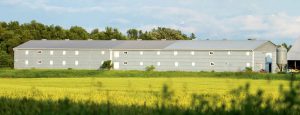
This cricket barn, at Entomo Farms, is approximately 20,000 sq. ft. and houses 35 million crickets. Image courtesy of Entomo Farms
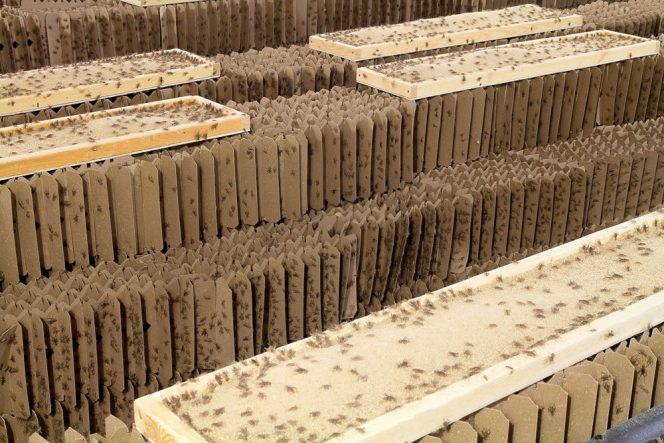
Crickets are raised in “cricket condos” comprised of cardboard partitions or egg-flat-like structures. In this photo, some “condos” have feeding trays (lighter, rectangular objects) sitting on top of them. Image courtesy of Entomo Farms
Crickets are common in food and feed worldwide; cricket powder can be found in certain protein bars. Notes Hénault-Ethier, “If you are going to farm crickets to feed humans, and using chicken feed to raise the crickets, that is okay because crickets are more efficient at converting feed to protein. But it makes no ecological sense to raise crickets on grain to feed to chickens. They can eat waste.” Although most cricket species are omnivorous and will readily consume fresh organic food waste, a human pathogen bacteria the waste may contain, Serratia marcescens, thrives in damp conditions and can be fatal. Some cricket farmers have been researching use of dried organic waste powders to minimize the potentially harmful bacteria, says Hénault-Ethier. “Powder is also easier for the crickets to eat, and can be homogenized and preserved at room temperature, thus eliminating the additional problem of nutritional variation of fresh organic waste.”
Nutritional consistency is key for Jarrod Goldin, president of Ontario-based Entomo Farms, which raises crickets and mealworms as both human and animal food. “The problem with food wastes is to have consistent input, as you may have days when you get all bananas and another all squash. If you’re adding an ingredient to anything, it should be consistent in its nutrition profile, because the only way to have consistent output is to have consistent input.” Goldin acknowledges that while food wastes are part of the solution to feeding his crickets, “feed producers should figure out how to dry it and make it more [nutritionally] consistent.” Some people have proposed precomposting food waste to heat it up and kill bacteria before giving it to insects, but explains Hénault-Ethier, that would reduce some of its nutritional value.
Fly larvae, especially Black Soldier Flies (BSF), are particularly voracious, consuming a wide range of organic materials, including animal and human waste. Such voracity makes them ideal choices for industrial-scale uses. At Enterra Feed Corp., BSF consume 100 tons of preconsumer organics daily. From that, about 54 tons of processed material are generated, says Henault-Ethier, comprising frass (insect feces), food waste and exoskeletons that can be used for soil enrichment. In addition, 25 tons of fresh larvae are produced. OVRSol founder Dr. D. Craig Sheppard, considered a pioneer on BSF biology, concurs with that estimate, noting that insect biomass conversion is approximately 25 percent on a “dry to dry” matter basis for most waste streams.BSF often are frozen, dried and sold whole. Indigenous to North America, BSF can grow on everything from fruit and vegetable waste to hen and pig manure, biosolids and liquid leachate from compost. Although BSF larvae can grow with almost any feedstock, caveats include avoiding too high a percentage of meat products as it results in high mortality, and too much lignin, as they appear to find it indigestible. Thus, hen and pig manure is preferable to cow dung, which has a higher lignin content. Several studies have reported excellent development rates and low mortality using unspecified “fruit and vegetable” waste streams.
Given the proper waste feedstock, research has shown that BSF larvae will reduce waste volumes on average between 65.5 to 78.9 percent. Henault-Ethier notes that BSF larvae have a relatively high tolerance for wet food. The more water in the waste, she said, the less dry matter will result at the other end.
Production Practices
Automation and economies of scale are needed to reduce the cost per ton of insects destined for animal feed, as it is currently the highest cost fish food alternative at $10,000/ton, according to Hénault-Ethier. Meanwhile, profit margins are low, despite a $45 to $55/kg ($20.45 – $25/lb.) price tag for cricket flour.
Mealworms and BSF are promising for automation, she adds. Mealworms, aimed at markets for feeding chicken and pets, are compact larvae, and thus more amenable to screening. In theory, mealworms can be fed either fresh or dry organic waste. Entomo Farms’ Goldin says it is easier to use wet food with mealworms, but Hénault-Ethier notes that “many people say mites can become a problem in mealworm farming when humidity levels get too high.”
BSF are good candidates to utilize at large-scale facilities, because they are indigenous, and the adults do not live long. “One of the main benefits of BSF is the migratory behavior of larvae about to pupate, explains Hénault-Ethier. “In search of a quiet place to pupate, they will climb up side walls and be caught falling on automated collection systems, making sorting much simpler. But to inoculate a new pile of organic waste, egg collection — scraping out the egg mass from the laying substrate — may remain a manual labor, even with the Black Soldier Fly.”
Adult BSF must fly to mate, thus need three-dimensional enclosures, which prompted EnviroFlight founder Glen Courtright to invent his own enclosure. The company patented a system to encourage mating. Adult flies are enclosed in tall, cylindrical wire cages inside a heated, humidified glasshouse. Lidded plastic containers with oviposition attractant are at the bottom of each cage.
Marsha W. Johnston is a Contributing Editor at BioCycle and an Editor at Earth Steward Associates in Arlington, VA.


